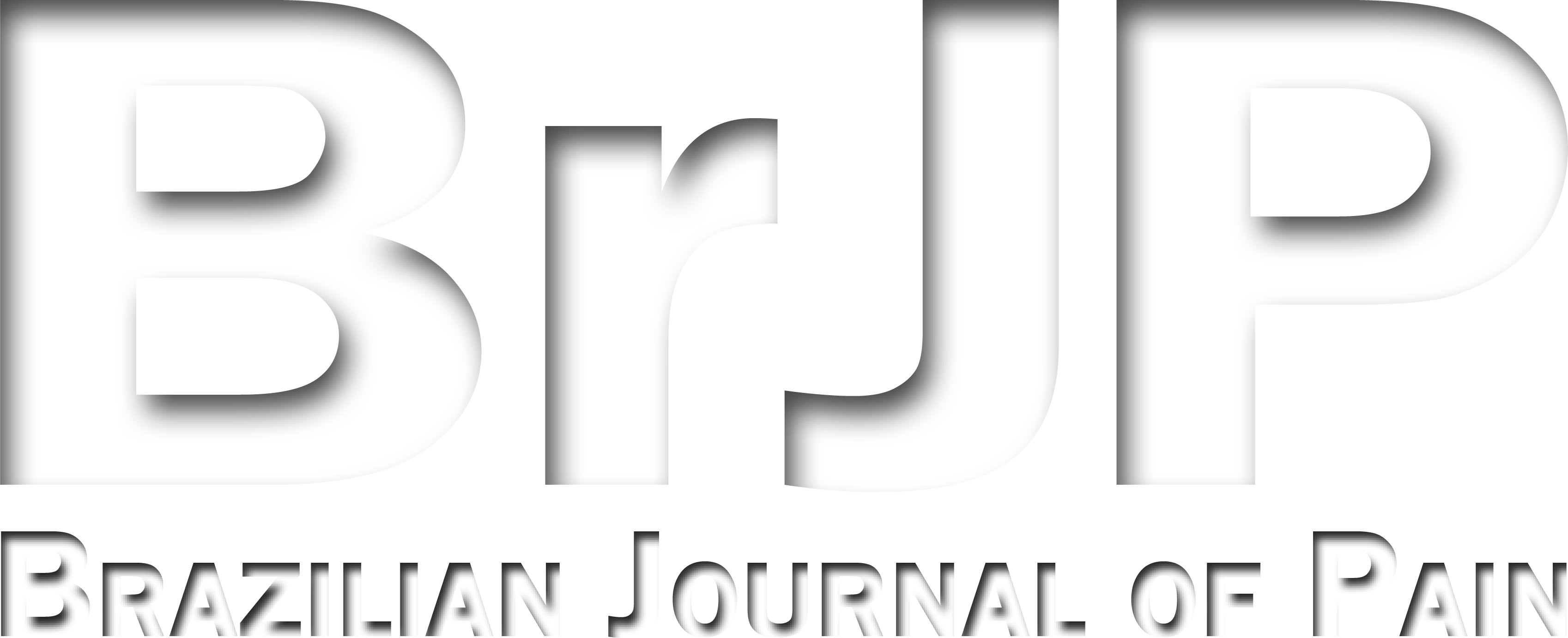Patients with chronic pain: degree of kinesiophobia related to dance practice
Pacientes com dor orofacial: grau de cinesiofobia relacionada a prática da dança de salão
Bianca Lopes Cavalcante-Leão; José Stechman-Neto; Gloria Maria Cortz Ravazzi; Alice Helena de Lima Santos; Rosane Sampaio; Bianca Simone Zeigelboim
Abstract
Keywords
Resumo
Palavras-chave
References
Merskey H, Bogduk N. Classification of chronic pain: descriptions of chronic pain syndromes and definitons of pain terms. 2010.
Sallum AM, Garcia DM, Sanches M. Dor aguda e crônica: revisão narrativa da literatura. Acta Paul Enferm. 2012;25(Special number 1):150-4.
Boggero IA, Rojas-Ramirez MV, de Leeuw R, Carlson CR. Satisfaction with life in orofacial pain disorders: associations and theoretical implications. J Oral Facial Pain Headache. 2016;30(2):99-106.
Sartoretto SC, Bello YD, Bona AD. Evidências científicas para o diagnóstico e tratamento da DTM e a relação com a oclusão e a ortodontia. RFO. 2012;17(3):352-9.
Miettinen O, Lahti S, Sipilä K. Psychosocial aspects of temporomandibular disorders and oral health-related quality-of-life. Acta Odontol Scand. 2012;70(4):331-6.
Liu F, Steinkeler A. Epidemiology, diagnosis, and treatment of temporomandibular disorders. Dent Clin North Am. 2013;57(3):465-79.
Souza JB. Poderia a atividade física induzir analgesia em pacientes com dor crônica. Rev Bras Med Esporte. 2009;15(2):145-50.
Oliveira MA, Fernandes RS, Daher SS. Impacto do exercício na dor crônica. Rev Bras Med Esporte. 2014;20(3):200-3.
Paraschiv-Ionescu A, Perruchoud C, Rutschmann B, Buchser E, Aminian K. Quantifying dimensions of physical behavior in chronic pain conditions. J Neuroeng Rehabil. 2016;13(1):85.
Palstam A, Larsson A, Löfgren M, Ernberg M, Bjersing J, Bileviciute-Ljungar I. Decrease of fear avoidance beliefs following person-centered progressive resistance exercise contributes to reduced pain disability in women with fibromyalgia: secondary exploratory analyses from a randomized controlled trial. Arthritis Res Ther. 2016;18(1):116.
Leung A, Gregory NS, Allen LA, Sluka KA. Regular physical activity prevents chronic pain by altering resident muscle macrophage phenotype and increasing interleukin-10 in mice. Pain. 2016;157(1):70-9.
Tarr B, Launay J, Dunbar RI. Silent disco: dancing in synchrony leads to elevated pain thresholds and social closeness. Evol Hum Behav. 2016;37(5):343-9.
Cunha ML, Landim FL, Lima MF, Vieira LJ, Mesquita RB, Collares PM. Dança de salão: repercussões nas atividades de vida diária. Cad Saúde Colet. 2008;16(3):559-68.
Murphy MK, Arzi B, Hu JC, Athanasiou KA. Tensile characterization of porcine temporomandibular joint disc attachments. J Dent Res. 2013;92(8):753-8.
Siqueira FB, Teixeira-Salmela LF, Magalhães LC. Análise das propriedades psicométricas da versão brasileira da escala tampa de cinesiofobia. Acta Ortop Bras. 2007;15(1):19-24.
Gil-Martínez A, Grande-Alonso M, López-de-Uralde-Villanueva I, López-López A, Fernández-Carnero J, La Touche R. Chronic temporomandibular disorders: disability, pain intensity and fear of movement. J Headache Pain. 2016;17(1):103.
Ahmad M, Schiffman EL. Temporomandibular joint disorders and orofacial pain. Dent Clin North Am. 2016;60(1):105-24.
Maraz A, Király O, Urbán R, Griffiths MD, Demetrovics Z. Why do you dance? Development of the dance motivation inventory (DMI). PLoS One. 2015;10(3).
Chantaracherd P, John MT, Hodges JS, Schiffman EL. Temporomandibular joint disorders' impact on pain, function, and disability. J Dent Res. 2015;94(3^sSuppl):79S-86S.
Kreling MC, da Cruz DA, Pimenta CA. Prevalence of chronic pain in adult workers. Rev Bras Enferm. 2006;59(4):509-13.
Monticone M, Ferrante S, Teli M, Rocca B, Foti C, Lovi A. Management of catastrophising and kinesiophobia improves rehabilitation after fusion for lumbar spondylolisthesis and stenosis. A randomised controlled trial. Eur Spine J. 2014;23(1):87-95.
van Wilgen CP, Dijkstra PU, Versteegen GJ, Fleuren MJ, Stewart R, van Wijhe M. Chronic pain and severe disuse syndrome: long-term outcome of an inpatient multidisciplinary cognitive behavioural programme. J Rehabil Med. 2009;41(3):122-8.
George SZ, Wittmer VT, Fillingim RB, Robinson ME. Comparison of graded exercise and graded exposure clinical outcomes for patients with chronic low back pain. J Orthop Sports Phys Ther. 2010;40(11):694-704.
Lundberg M, Styf J. Kinesiophobia among physiological overusers with musculoskeletal pain. Eur J Pain. 2009;13(6):655-9.
Verbunt JA, Seelen HA, Vlaeyen JW, van der Heijden GJ, Knottnerus JA. Fear of injury and physical deconditioning in patients with chronic low back pain. Arch Phys Med Rehabil. 2003;84(8):1227-32.
Norris C, Matthews M. The role of an integrated back stability program in patients with chronic low back pain. Complement Ther Clin Pract. 2008;14(4):255-63.
Marley J, Tully MA, Porter-Armstrong A, Bunting B, O'Hanlon J, McDonough SM. A systematic review of interventions aimed at increasing physical activity in adults with chronic musculoskeletal pain--protocol. Syst Rev. 2014;3:106.
He S, Wang J, Ji P. Validation of the Tampa Scale for Kinesiophobia for temporomandibular disorders (TSK-TMD) in patients with painful TMD. J Headache Pain. 2016;17(1):109.
Submitted date:
03/19/2018
Accepted date:
07/17/2018


